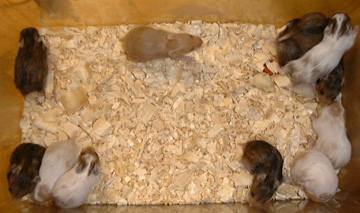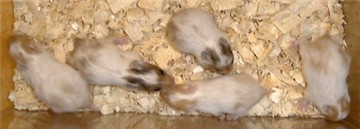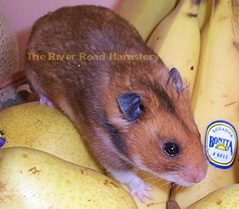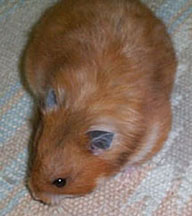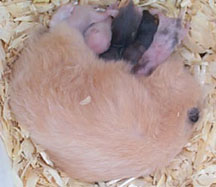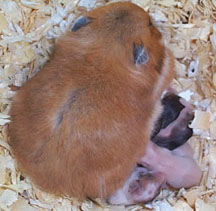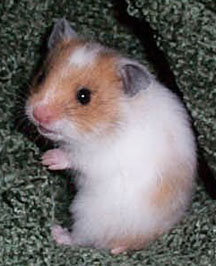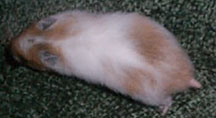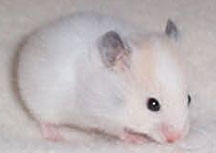
Contents
RRH Index
Extreme Dilute
Syrian Hamsters
Description
History
Genetics
Breeding
Experimental Proofs of
Gene Character and
Transmission
Albinism
ED Photo Gallery
Recessive Dappled
Syrian Hamsters
Description
History
Genetics
Breeding
Experimental Proofs of
Gene Character and
Transmission
Comparison to Other
Patterns
Testing for Allelism with
Dominant Spot
RD Photo Gallery
Working on Type
Syrian Hamster
Genetics
Contact
|
Experimental Proofs of Gene Character and Transmission for the Recessive Dappled Pattern in Syrian Hamsters When the "Wide Banded" pattern came to the attention of the River Road Hamstery, it was clear that the evidence for it being a recessive single-gene pattern was supportive but not conclusive. Spice Teddybear Hamstery collected data on all the relevant crosses done with the hamters up until that point, and both hamsteries planned breeding to delineate the gene. The definitive cross had to be between two unpatterned hamsters both of which were presumed carriers, producing patterned pups in the litter. This would prove that the gene was recessive. As of August 2000, there had been ten matings between an Estonian-patterned hamster and a hamster with one Estonian-patterned parent. These resulted in litters that were roughly 50% solid and 50% patterned. This would be expected whether the gene was dominant or recessive, so offered no useful information. Three crosses between two of the patterned hamsters produced 100% patterned litters. Three crosses between a patterned hamster and a definitely unrelated solid from U.S. stock yielded 100% solid litters. These results suggested but did not prove that the gene was recessive and, therefore, completely different from the known pattern genes. (The only other recessive pattern gene known to have existed outside of labs is Piebald which may now be extinct, and unlike the pattern here, it produced color on the ventral surface.) There was only one mating between solid hamsters both of which had one patterned parent. If the pattern gene were recessive, then each of these would be a carrier. This single cross produced a litter of four, one of which was patterned, proving the recessive nature.
There were two other crosses of note from the Delaware breeders. One was a Recessive Dappled crossed to a Dominant Spot. The litter was a mix of Dominant Spots and solids. The other was between a Recessive Dappled and a standard Banded. The litter was solid and Banded. The patterning on the pups in these litters was typical for the pattern indicated and not intermediate in form. (The photos in the preceeding section are courtesy of Spice Teddybear Hamstery.)
The structured breeding efforts from both hamsteries prove that the pattern is caused by a recessive gene. This has since been supported by numerous other litters. It has never split into two patterns, as would be the case with a Dominant Spot Banded. The pattern itself has seemed to change somewhat over the generations with color creeping anteriorly up the back, but this remains a variable feature. The expected percentage of Recessive Dappled hamsters born to parents who are both carriers of the gene is 25%. In litters of this size then, one would expect to see about 3 or 4 in each litter. That there were only half that many could easily be a chance phenomenon or it could be an indication of reduced viability associated with the pattern. The latter has not been indicated by the numbers of Recessive Dappled hamsters in other litters. |
||||||||||||||||||||||||||

No part of this website may be reproduced in any form or by any means
without the prior written consent of the owner.
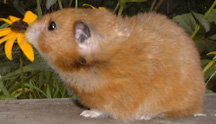 To replicate these results and increase their credibility, another cross was made in July 2000 between an unpatterned Golden female that came from a patterned parent and an unpatterned Golden male
that had a patterned grandparent on each side but unpatterned parents. (His chances of being a carrier were only 2/3.) Pictured here is the dam whose mother was a Golden Dominant Spot and father was an Estonian-patterned Golden.
To replicate these results and increase their credibility, another cross was made in July 2000 between an unpatterned Golden female that came from a patterned parent and an unpatterned Golden male
that had a patterned grandparent on each side but unpatterned parents. (His chances of being a carrier were only 2/3.) Pictured here is the dam whose mother was a Golden Dominant Spot and father was an Estonian-patterned Golden.